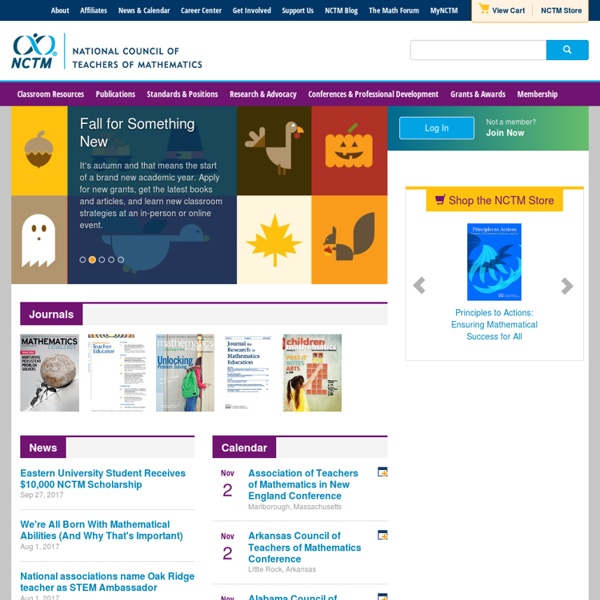



Elementary Mathematics Professional Development "A deeper understanding of Mathematical fluency enables us to envision what it means for our students to be mathematically proficient, and to shift teaching practices that shift our teaching from a focus on content to a focus on application and understanding" Sue O'Connell and John SanGiovanni from Putting the Practices into Action The aim of this series of instructional and collaborative professional learning experiences is to provide opportunities, ideas, and a venue for teachers to work collaboratively to enhance and further develop their Professional Capital (as described by Fullan and Hargreaves, cited in A Great School for All - ATA, 2012). Guiding Questions for educators to consider
NRich Maths Teachers Primary Pupils Secondary Students Events and PD Finding It for Free By Meredith Scaggs Found in: Advice & Support It came from catastrophe. In 2008, the Cedar River overflowed, flooding 10 square miles of the city of Cedar Rapids, Iowa. Thinkfinity Browse Resources Verizon Foundation proudly partners with some of the country’s top educational organizations to provide you with the latest topics, tools and trends in education. Created by the John F. Kennedy Center for the Performing Arts, ARTSEDGE provides resources and examples for teachers to teach in, through and about the arts. The site includes lesson plans, advocacy and professional development resources, and up-to-date information on arts programs from around the world.
AB Education - Teaching Strategies for Creating an Effective Math Environment Creating an Effective Mathematics Environment Before instruction begins, it is important to create an effective classroom atmosphere in which learners feel safe and motivated to collaborate, cooperate and engage in the pursuit of mathematical understanding. Research from the learning sciences indicates that successful learning happens when students are immersed in environments that are learner-centred, knowledge-centred and assessment-centred. In these environments, teachers are able to:
theconversation New research has found some teachers mark boys' primary (elementary) school maths tests more favourably than girls, impacting girls' uptake of advanced mathematics and science subjects in high school. Entrance rates into maths and science degrees at university level can also be traced back to the impacts of teachers' gender bias in primary school. Higher levels of mathematics and science education have been linked to greater employment opportunities and higher earnings, meaning a primary teacher’s attitude towards maths can have a serious impact on a child’s future success. Teachers assume boys are better at maths My Beginning of the Year Parent Questionnaire Two of my three kids; and that’s who this is all about Yesterday I shared my student questionnaire so I find it only apt to share my parent questionnaire as well. While there are so many things I wanted to ask my parents, I wanted to keep it short and to the point. As always, feel free to make a copy and make it your own.
Interactive Whiteboard Teacher Tools ↓ Skip to Main Content Home Resources Teacher Tools Numbers to Ten on the TenFrame Alberta Assessment Consortium - Supporting Mathematical Thinking in Elementary Classrooms Through Formative Assessment Teachers in Alberta are working with instructional strategies that are designed to help students become more confident mathematicians. While we want students to be fluent with calculations, we also want them to demonstrate their growing understanding of mathematics as they investigate, solve problems, reason and explain their thinking. This broader focus requires adjustments to traditional assessment practices. In this video series, watch how formative assessment can be used to support student learning. These materials were developed by the Alberta Assessment Consortium as a result of a grant from Alberta Education.
Lessons by Mathalicious My Two Left Feet Should shoe companies sell left and right shoes separately? Students collect survey and measurement data, construct bar graphs, and discuss distributions and measures of central tendency in order to figure out whether shoe companies should necessarily be selling their products in same-size pairs. Topic: Statistics and Probability (SP) Visible Thinking Purpose and Goals Visible Thinking is a flexible and systematic research-based approach to integrating the development of students' thinking with content learning across subject matters. An extensive and adaptable collection of practices, Visible Thinking has a double goal: on the one hand, to cultivate students' thinking skills and dispositions, and, on the other, to deepen content learning. By thinking dispositions, we mean curiosity, concern for truth and understanding, a creative mindset, not just being skilled but also alert to thinking and learning opportunities and eager to take them Who is it for? Visible Thinking is for teachers, school leaders and administrators in K - 12 schools who want to encourage the development of a culture of thinking in their classrooms and schools. Key Features and Practices At the core of Visible Thinking are practices that help make thinking visible: Thinking Routines loosely guide learners' thought processes and encourage active processing.